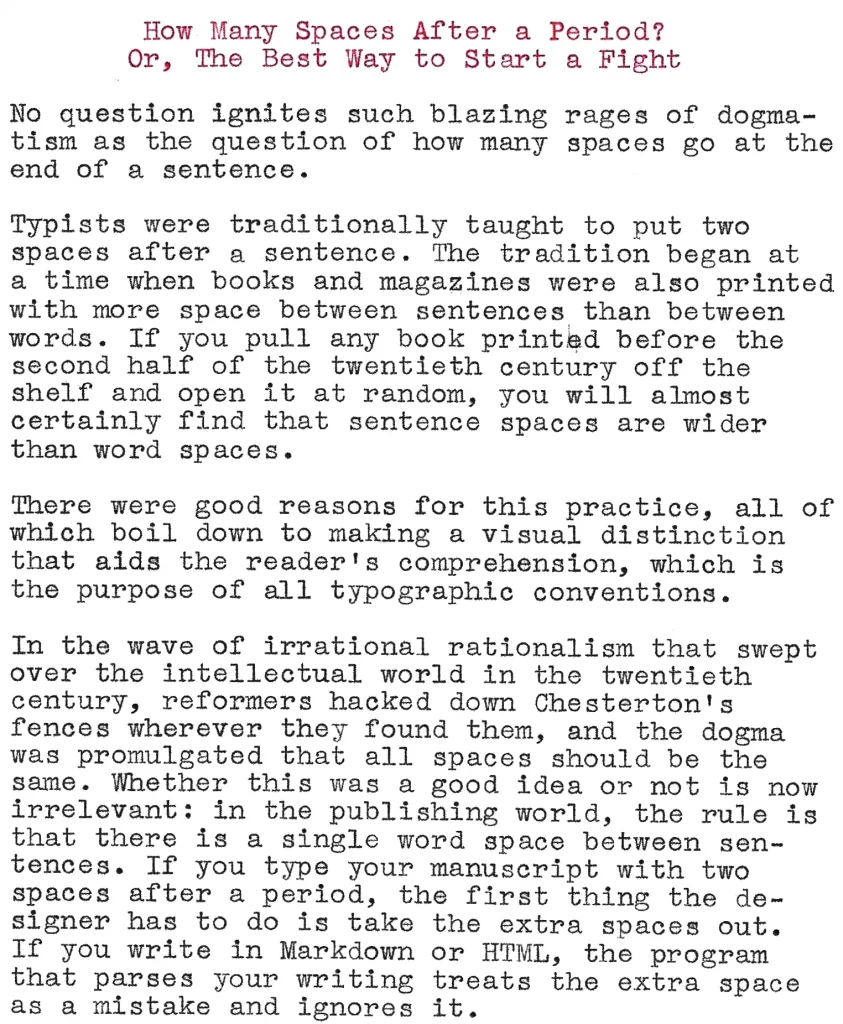



Transcribed below.
How Many Spaces After a Period? Or, The Best Way to Start a Fight
No question ignites such blazing rages of dogmatism as the question of how many spaces go at the end of a sentence.
Typists were traditionally taught to put two spaces after a sentence. The tradition began at a time when books and magazines were also printed
with more space between sentences than between words. If you pull any book printed before the second half of the twentieth century off the shelf and open it at random, you will almost certainly find that sentence spaces are wider than word spaces.
There were good reasons for this practice, all of which boil down to making a visual distinction that aids the reader’s comprehension, which is the purpose of all typographic conventions.
In the wave of irrational rationalism that swept over the intellectual world in the twentieth century, reformers hacked down Chesterton’s fences wherever they found them, and the dogma was promulgated that all spaces should be the same. Whether this was a good idea or not is now irrelevant: in the publishing world, the rule is that there is a single word space between sen- tences. If you type your manuscript with two spaces after a period, the first thing the de- signer has to do is take the extra spaces out. If you write in Markdown or HTML, the program that parses your writing treats the extra space as a mistake and ignores it.
Yet it appears that typing classes—by which we mean keyboarding classes, of course—still sometimes teach the doctrine that you must type two spaces after a sentence. Every once in a while, we see a writer turn purple with righteous wrath when he discovers that his spaces have been lost in the published version of his manuscript. There is no reasoning with him when he has made the discovery: he knows, because he learned it in his high-school typing class, that there must be two spaces after a sentence; and if the editor is of a different opinion, then the editor is objectively wrong and personally responsible for the collapse of literate culture in this country.
We also see designers turning purple—or perhaps some more designerly color, like mauve—when they encounter the writers who type two spaces after a period. The designers know, because they have learned it wherever designers learn their trade, that it is now and has always been correct to use a single word space after a sentence. There was never a time when it was otherwise: the text on Khufu’s pyramid was written with single spaces, and they don’t have to look it up because they know. It can be amusing to show those designers one old book after another and watch them dismiss it as a mistake or an anomaly, but the game gets old after the fifth or sixth book.
When two dogmatic rages collide like that, no amount of research or fact-checking will stop the fight. It has become a matter of religion, not history, and a sane observer does not stand between two religious fanatics bent on holy war. A sane observer stands to one side, makes popcorn, and enjoys the show.
But meanwhile, as a practicing typist, what should you do? One space or two?
Do whatever fits your ingrained habits: that is the only reasonable answer. It is not worth trying to form new habits if you have been building up your old ones for years. If you are writing for publication and you type two spaces, the conversion is so easy that no easy that no one should be inconvenienced by it. It takes one global search and replace. If your editor or designer puts any more effort than that into it, that is not your fault.
You may have noticed that this site uses single spaces after sentences. That is the result of decades spent writing for modern publications, not an indication of any strong opinion on which style is better. There are more entertaining things to argue about than the number of spaces after a period. But there are few more entertaining arguments to watch from a safe distance.
Royal Quiet De Luxe
Pica type

Leave a Reply